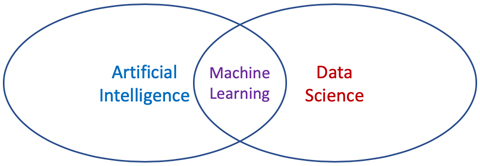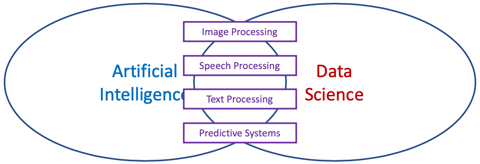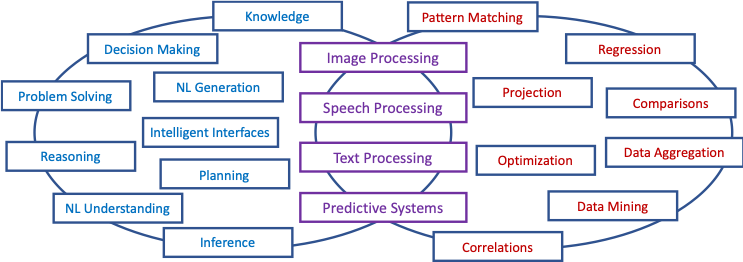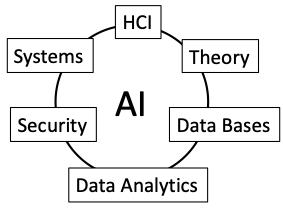Artificial Intelligence at Northwestern: A View from Computer Science
Background: From Research to Impact
The field of Artificial Intelligence (AI) has changed a great deal over the past decade. The influx of masses of data has both inspired the development of new technologies and powered existing technologies that have been nurtured in labs for years. The technologies of statistical machine learning (ML), deep learning, recommendation, text analysis, etc., have all seen their reach increase tremendously, in no small part because the data that supports them are now readily available. Moreover, symbolic representations of knowledge have been scaled out to large-scale knowledge graphs that contain billions of facts, and are used daily by Google, Microsoft, Amazon, Spotify, and others to improve their services.
Many of the commercial successes are hybrids, e.g. software assistants are built of a combination of symbolic representations to describe intent and answer questions, with statistical approaches to speech and language processing. What had been interesting research technologies are now powerful applications that are having impact in business, commerce, communication, medicine, and education.
 Some of the most visible successes in Artificial Intelligence exist at the intersection of AI and Data Science. The availability of massive data sets, and the computation needed to process, refine and distill models from it, has led to the scaling of learning that was previously impossible. This has revolutionized machine learning and provided tools that are being used across AI to develop new capabilities. These tools include the now ubiquitous technologies of speech and image recognition, large scale text processing, and the core technologies of prediction.
Some of the most visible successes in Artificial Intelligence exist at the intersection of AI and Data Science. The availability of massive data sets, and the computation needed to process, refine and distill models from it, has led to the scaling of learning that was previously impossible. This has revolutionized machine learning and provided tools that are being used across AI to develop new capabilities. These tools include the now ubiquitous technologies of speech and image recognition, large scale text processing, and the core technologies of prediction.
 These technologies have, in turn, been used to develop the interfaces that connect us to personal assistants, facial recognition systems, important components of self-driving cars, statistical approaches to diagnostic systems, text-based sentiment analysis, and statistical classification systems. The result is that many of the components of what is thought of as machine intelligence are supported by these data-driven technologies that are utilized by both Data Science and AI.
These technologies have, in turn, been used to develop the interfaces that connect us to personal assistants, facial recognition systems, important components of self-driving cars, statistical approaches to diagnostic systems, text-based sentiment analysis, and statistical classification systems. The result is that many of the components of what is thought of as machine intelligence are supported by these data-driven technologies that are utilized by both Data Science and AI.
The success of these scalable methods in support of AI has resulted in three trends:
- First, AI is now front and center in the public eye and is seen as a disrupter across nearly every industry.
- Second, the ecosystem is now filled with AI and machine learning tools that are easily adopted by most developers.
- Third, with the new tools that are available, we are seeing more use of AI by designers and developers who are more focused on the outcomes than on the details of the technologies that they are employing.
While the core technologies of machine learning are effective in those situations where there are large data sets, it is important to understand that machine learning is itself instrumental to other functionalities. Machine learning applied to speech and image processing supports the first step in dialog systems and face recognition applications. Applied to categorization and prediction, it supports diagnosis and advisory systems. And applied to tasks in which new knowledge can be derived from data, learning supports core reasoning tasks such as decision making, problem solving, and both language understanding and generation. These capabilities are based on more semantic approaches, but are benefiting from the expanded knowledge sets that flow from statistical techniques.
 While there are substantial areas of research that are shared between AI and Data Science, it is important to understand that each of these two fields is far more than their intersection. For Data Science, work associated with the gathering, maintenance, organization, and efficient computation of data is outside of what would ever be considered Artificial Intelligence. Likewise, work in planning, problem solving, inference, decision making, and the management of knowledge is outside of the realm of the statistical and analytical methods of Data Science.
While there are substantial areas of research that are shared between AI and Data Science, it is important to understand that each of these two fields is far more than their intersection. For Data Science, work associated with the gathering, maintenance, organization, and efficient computation of data is outside of what would ever be considered Artificial Intelligence. Likewise, work in planning, problem solving, inference, decision making, and the management of knowledge is outside of the realm of the statistical and analytical methods of Data Science.
Finally, because of the ability to scale many of the underlying statistical technologies, there has been a strong push by the major technology companies (e.g., Google, Microsoft, IBM, and AWS) to develop and publish tools in the form of APIs that are available for open use. In parallel, developers and researchers have been producing open source libraries for learning, language processing, image recognition, etc. Some technologies that only existed in laboratories 10 years ago are now not only available but completely commoditized. Five years ago, building a system that utilizes a Convolutional Neural Network to do image processing would have required a PhD-level AI researcher with specific expertise in the area. Today, it requires a junior programmer and a credit card. There are serious issues associated with the quality and reliability of the resulting systems, as well as when they should and should not be used, but the reality is that they are here and being used aggressively today.
Impact on the Academy: Application and Research
These trends are not confined to the private sector. We see them in the academy as well, with field after field adopting the technologies of AI and Data Science in order to address problems ranging from image-based diagnosis, text analytics used to understand and classify communication, and speech recognition as the front end for data retrieval systems. Using the newly emergent tools, these technologies can now be brought into play by researchers with domain expertise even when they may not have expertise in the underlying technologies that they are utilizing. This has led to the rise of “Artificial Intelligence” groups across a wide range of fields.
While there are exceptions, these groups are generally characterized by two primary features:
- First, they are far more focused on the application of AI technologies to the problems defined by their fields than on research into the nature of the technologies themselves. As one would expect, they are interested in their own research areas and see various AI technologies as tools to forward that research.
- Second, because of the nature of the tools that are actually available, their focus is on the capabilities that are defined by the statistical machine learning systems that are most easily applied today. Again, as one would expect, they are using the available tools and those tools are primarily statistical in nature.
However, and equally to be expected, the tools that make certain aspects of AI easily available to non-experts are not necessarily the focus of active AI researchers simply because the tools tend to be limited in scope and capability. These tools empower the wide utilization of some capabilities, but often do little for researchers who are trying to advance the state of the art in AI. In many cases, active researchers see these tools as the lowest common denominator that may be useful but may give a misleading impression that the field is “solved,” which is at odds with the reality of the state of the science.
As a result, there are instances in which AI researchers are sometimes troubled by the adoption of these tools by research groups in other fields who are building applications based on them. This often plays out as the view that researchers in other fields are utilizing technologies and tools that they don’t understand and, from the AI point of view, may be incomplete or, in some cases, simply wrong for the task at hand. This tension can be overcome, but it is important to understand that it is part of the dynamic of the advancement of AI and ML in both the private sector and the academy.
This combination of research and application also includes the study of the impact of AI itself. This work includes considerations of how it is disrupting business, our response to it from the perspective of public policy and regulation, and issues of law and ethics that flow from the development of independent intelligent systems.
Within universities across the country, these themes define three areas of activity:
- Research: Active research, mainly within CS departments, aimed at advancing the state of the art in Artificial Intelligence and Machine Learning.
- Application: Application of the current state of the art, in the form of existing systems and tools, to problems in fields across the academic spectrum.
- Impact: Studies of the various ways in which AI is changing the world and how we can respond to those changes.
While different in nature, all three of these activities can benefit from the interaction between researchers in other areas. The coordination of research, application, and the study of impact serves all three. We have already seen approaches to this coordination reap solid rewards at schools such as MIT, Cornell, Georgia Tech, and Carnegie Mellon University. Each of these schools has embraced an integrated approach in which research is tightly linked to impact. The result of this integration has been both research excellence and the ongoing flow of ideas and systems out of these schools into actual use.
Artificial Intelligence at Northwestern
Northwestern has a rich collection of active and vibrant Artificial Intelligence communities doing research and application in nearly every school.
AI in Computer Science
Computer Science at Northwestern includes a substantial and influential AI group with significant and ongoing work in Natural Language Processing and Generation, planning and problem solving, cognitive modeling, interactive intelligent systems, robotics, and machine learning. This group includes nine core faculty doing work in machine learning, robotics, language understanding and generation, human-robot interaction, social media analysis, computational journalism, audio analysis, computers and education, and legal reasoning.
The AI group is focused on the core problems of AI and also has research and development connections to every school across the Northwestern campus. AI within CS also includes a number of research and teaching faculty and post-docs, over 30 PhD students, and scores of Master of Science and undergraduate students. In particular, CS supports the newly created Master of Science in Artificial Intelligence (MSAI) that currently trains 20 students a year and is expanding to include applicants from outside of Computer  Science in an effort to introduce AI to students with advanced degrees in Medicine, the Law, and Business.
Science in an effort to introduce AI to students with advanced degrees in Medicine, the Law, and Business.
Modern AI is far broader than machine learning or deep learning and the AI group within CS reflects this fact. With research cutting across the different aspects of AI it is also linked to the other areas of CS including work in Theory, Systems, Data Bases and Human Computer Interaction. The CS department at Northwestern is fortunate in that it has world class researchers in all of these areas who both collaborate with and support AI researchers and their work.
AI at Northwestern Broadly
While CS is at the center of AI as a research focus, there is other activity across the campus.
- McCormick School of Engineering
Within McCormick, there is research in IEMS and in ECE in machine learning, image processing, and optimization that both expands the reach of many of these technologies and provides results that can improve them. Likewise, work growing out of Data Science and Analytics initiatives have led to application of the tools of machine learning. There is related research in a variety of areas, including Chemical and Biological Engineering. - Kellogg School of Management
At the J.L. Kellogg School of Management, machine learning is being applied in those areas where data analytics were already being used as part of the tool set for marketing and strategic analysis. It is also the focus of work in how technology is impacting business and can drive organizational change. - Pritzker School of Law
Similarly, Pritzker School of Law is embracing AI from the perspective of both a technology that needs to be studied from a regulatory point of view, and as the source of applications that could disrupt the law as a practice. Recent classes and hires have been aimed at explicitly supporting both these efforts. - Medill School of Journalism, Media, Integrated Marketing Communications
At Medill School of Journalism, Media, Integrated Marketing Communications, there are initiatives in both the Journalism and Integrated Marketing Communications departments in how to integrate AI and Data Science into their own work. These efforts are embodied in both the Knight Lab (Journalism) and the recently formed Retail AI Lab (IMC). - School of Communication
At the School of Communication, the Technology and Social Behavior program includes the study of AI and ML from the perspective of fairness, transparency and social impact. - Weinberg College of Arts and Sciences
At Weinberg College of Arts and Sciences, the Cognitive Science program has always had AI as one of its three pillars alongside Psychology and Learning Sciences. More recently, there has been a growing awareness that there needs to be a tighter relationship between CS and Statistics especially given that much recent work in AI grows out of statistical approaches. - Feinberg School of Medicine
Within Feinberg School of Medicine there are multiple groups that are investing time and money to develop the skill sets needed to apply a wide range of AI technologies to problems of image understanding, diagnosis, prediction and intervention. This includes work in Radiology, Preventative Medicine, and Cardiology with its new AI in Cardiology Center.
Interactions
While understanding the work of each of the different groups either researching or utilizing AI is important, it is also important to understand how they are interacting with each other. In this section, we are going to map out some of those interactions, particularly those related to the Master of Science in Artificial Intelligence (MSAI) and the Computer Science Department’s CS+X initiative. There are certainly other connections between the various groups, but these two initiatives are, by their natures, designed to support interactions across different groups.
- Master of Science in Artificial Intelligence (MSAI)
From its inception, the MSAI program was designed to integrate across different areas of AI (semantics and statistics), various aspects of Computer Science (Data Science, Human Computer Interaction, and Software Engineering), and different disciplines related to the application of the technologies in the world (Cognitive Psychology and business practice). As part of the program, we brought in lecturers to provide a point of view on the ethical and legal implications of AI that included connections to Pritzker and Weinberg.
We also have brought in a wide range of companies that are either working on the development of AI systems directly or looking to apply AI technologies to their current work flow. Over the past three quarters, we invited about 30 companies to either present their work or pitch their problems to the students (See Appendix A). These visits have resulted in internships and internal research projects. Even in those cases where there are not immediate results, we are using MSAI as a mechanism for building ongoing relationships with companies that are interested in the technologies we are teaching.
As of this spring, we have projects with external companies and not-for-profits that include Northwestern Memorial Hospital, Solstice Technologies, Feinberg’s Department of Radiology, Northwestern’s football team, and Greenkey Technologies. And our MSAI students are already interning with companies such as Deloitte, Abbott, and Briteseed Medical.
Because so much of the work in Artificial Intelligence is driven by the tools provided by the different platform companies, MSAI has also been aggressive about bringing in representatives from Google, Microsoft, AWS and IBM to provide students with training in their cognitive computing and machine learning tools and give them access to those tools for project and class use. Our goal in the coming year is to expand this to develop “Tools and Techniques” classes supported by these companies for both the MSAI students and our undergraduates.
In an effort to bring in multiple perspective on AI and its impact, the MSAI program has brought in a wide range of speakers from these companies to discuss the application of AI and implications associated with its use that go beyond the technologies themselves. - CS+X
While CS+X is an initiative that is more broadly focused than just Artificial Intelligence, AI is at the center of many discussions simply because of the wide applicability of the various technologies of machine learning and language processing. It is also a mechanism for us to develop approaches to interaction that include classes, workshops, and speakers as well as direct research connections.
Both of these programs have led to conversations and relationships that scope beyond the programs themselves.
Conclusions
There is a tremendous amount of activity in Artificial Intelligence at Northwestern. There is a globally recognized depth of AI expertise within Computer Science and the applied work in AI all across the University is impressive. The challenge is to harness this work to expand on the core research expertise to both support and amplify the impact of the applied work while keeping a policy eye on the implications of the new technologies as they emerge.
Of course, every challenge is best seen as an opportunity.
The interdisciplinary history of Northwestern and the Whole Brain approach to research at McCormick School of Engineering puts us in a unique position in which we can execute on a cross-disciplinary strategy that leverages our existing strengths in rigorous research, forward looking applications, and the thoughtful study of their impact.
Northwestern is in an enviable position. Building on the success of our interconnected research, we are creating a model of “AI Everywhere” that supports and integrates these three dimensions. We are creating a future in which world class AI research is aggressively moved into practice across the University, guided by a deep understanding of the science, its capacity to transform, and our ability to anticipate and guide its impact.
